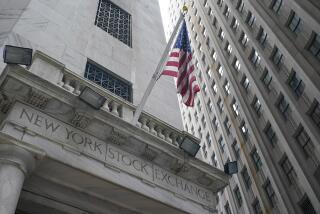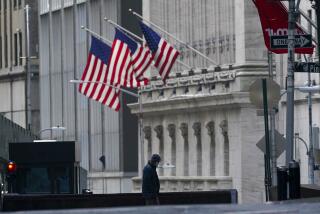For the dollar, a ‘crisis’ is relative
Housing crisis, 2007. Banking crisis, 2008. Unemployment crisis, 2009. European debt crisis, 2010.
For 2011: a dollar crisis?
You will probably hear more warnings to that effect soon if the U.S. currency continues on its current path. Although the dollar has mostly been falling against its major foreign rivals since 2001, the slide this spring is taking it to levels that fit conveniently with a variety of doomsday predictions for the economy.
What better symbol of debt-hobbled America’s decline than the collapse of the once almighty dollar?
Except the dollar isn’t collapsing -- not yet, anyway. It is, however, weak and getting weaker. And you may be having your own personal dollar disaster if you were planning to take a foreign vacation soon. The greenback’s loss of purchasing power in much of the world may scuttle more than a few overseas jaunts by Americans.
But the kind of dollar crisis envisioned in most doomsday scenarios would entail investors fleeing dollar-denominated stocks and bonds in a mad rush. And there’s no sign of that.
The Dow Jones industrial average ended this holiday-shortened week at 12,505.99, its highest level since June 2008. Most broader stock indexes are within 1% of their recent highs.
In the bond market, yields on Treasury securities have mostly moved lower over the last two weeks. Ditto for yields on most corporate and municipal bonds. A selling binge would mean higher, not lower, yields.
Still, it’s easy to see why the dollar’s latest slump would set off alarms. A closely watched index of the buck’s value against six other major currencies, including the euro and the yen, fell this week to its lowest level since August 2008.
The DXY index, so named for its ticker symbol, fell for a fourth straight week to end Friday at 74.14. It’s now down 6.2% year to date. If the index slides 3.8% from here it would drop through its all-time low of 71.33 reached in April 2008.
New lows on market indexes tend to get people’s attention. But unlike falling stock or home prices, which carry clear negative implications for the economy, a weaker dollar has some significant upsides.
For one, it can make U.S. companies more competitive with the rest of the world by lowering the prices of American exports for foreign buyers. And as the greenback falls, profit earned in stronger currencies abroad translates into more dollars.
The benefits of a declining dollar showed up this week in first-quarter earnings reports from multinational companies such as IBM Corp., Intel Corp., United Technologies Corp., Johnson & Johnson and Honeywell International Inc. All reported results above expectations, thanks to robust global demand for their goods and services.
Downward pressure on the dollar has been one objective of the Federal Reserve’s easy-credit policy, as the central bank works to boost the economy. The Fed is holding short-term interest rates near zero and is trying to hold long-term rates down via its purchases of Treasury securities.
Meanwhile, central banks in Europe, China, India, Brazil and elsewhere around the globe have been raising interest rates to combat energy and food inflation.
The market sets currency values based on a number of variables, but a crucial one is a country’s interest-rate levels: If higher rates attract more capital to a currency, its value should rise.
On Wednesday, Brazil’s central bank raised its key short-term rate to 12% from 11.75%, the sixth increase in the last 12 months. Brazil’s currency, the real, rose to its strongest level against the dollar since August 2008: The buck now is worth just 1.566 reals, down 5.7% from the start of this year and down nearly 11% from a year earlier.
For Americans, a trip to Rio has gotten a lot more expensive. The flip side is that Brazilians’ purchasing power in the U.S. has surged.
The Fed, then, looks like it’s getting exactly what it wanted in fostering a drop in the dollar as a way to stimulate the domestic economy.
But some of America’s trading partners aren’t so supportive. Russian Prime Minister Vladimir Putin this week called U.S. monetary policy “hooliganism” for flooding the world with cheap dollars.
One side effect of a weak dollar is that it has become a source of fuel for market speculation, notes Michael Woolfolk, currency strategist at Bank of New York Mellon. Hedge funds and other investors worldwide can borrow dollars at low interest rates and use that money to buy other assets, including emerging-market stocks and commodities.
U.S. crude oil prices, which ended the week at $112.29 a barrel, just under a 2 1/2-year high, have been driven up this year largely by the unrest sweeping the Middle East and North Africa. But because oil and other raw materials are traded in dollars, as the buck slides commodities get cheaper for investors whose own currencies are rising.
It’s an invitation to speculation, which in turn feeds inflation in hard assets, including energy and food.
Russia might like the higher prices it gets for its oil exports, but it also fears the surge in prices will lead to a bust.
Global investors have another dollar-related incentive to pile into commodities: If they expect that the U.S. won’t rein in its record budget deficits and that Treasury borrowing will continue to mushroom, hard assets become a potential hedge against U.S. fiscal calamity that could drive interest rates sky high.
The dollar’s further descent this week followed credit-rating firm Standard & Poor’s warning Monday that the U.S. could lose its AAA debt rating in the next two years if the deficits aren’t pared.
Could S&P;’s threat be enough to spark a genuine dollar crisis?
Barry Eichengreen, a UC Berkeley economics professor, chronicled the dollar’s history in his book, “Exorbitant Privilege: The Rise and Fall of the Dollar and the Future of the International Monetary System,” published this year. Although he believes that the dollar is in a long-term decline, he said he doubted that we’re headed for a currency meltdown in the near term.
There’s a practical barrier to a sudden collapse, Eichengreen said: “There has to be somewhere to flee to.” The dollar remains preeminent as the world’s primary currency, and no other paper currency has the market presence to take over for the greenback. Neither do gold or silver.
Still, he expects that the dollar’s status will continue to erode over the next few years, and that both the euro and the Chinese yuan will become more viable alternatives to the U.S. currency for global investors weary of seeing their dollar holdings devalued.
If the world feels less compelled to hold dollars, one result will probably be higher interest rates if the Treasury remains on a borrowing bender. So S&P;’s warning about U.S. debt levels should be taken seriously in Washington, Eichengreen said. “This will hopefully concentrate the minds of the politicians.”
But with the dollar already so weak, one risk in betting against it is that there may just be too many people on that side of the boat now. If real progress is made in attacking the deficits, or if the Fed were to signal that it will begin tightening monetary policy, the surprise could be how quickly the dollar could stage at least a temporary rebound.
“If there’s one thing that I don’t like, it’s that a lot of people are bearish on the dollar,” said Axel Merk, who manages the Palo Alto mutual fund Merk Hard Currency, which invests primarily in the U.S. currency’s rivals.
Then again, he said, the world is bearish on the buck for plenty of good reasons.
--
More to Read
Inside the business of entertainment
The Wide Shot brings you news, analysis and insights on everything from streaming wars to production — and what it all means for the future.
You may occasionally receive promotional content from the Los Angeles Times.







